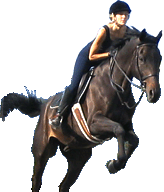|
Horses thrived and survived in various regions and climates. Each
area developed distinct breeds with qualities that were vital to
the people of that region. In many ways, horses changed the lives
of the people they served.
Desert Nomads and Horses
In the desert and grasslands, camels are more practical as they
can survive long periods without food and water, unlike horses.
As a result few true desert bred horses exist today, so they are
rarely seen in show rings, remaining mostly for breeding. Other
desert type horses evolved, but none were ever considered by the
Bedouins for their Arabians.
The nomadic people were the first to domesticate horses. They encouraged
both pacing and other flying gaits which could carry their tribes
long distances without tiring the horses. The severe climate required
the nomads to share food and water, and sometimes even their tents
with their horses.
In addition, with the nomadic nature of the Gypsy peoples, their
horses had to be adaptable to varying climates, terrains and living
conditions. The result of this culling has led to the Gypsy Vanner
Horse being one of the most docile horses in the world.
Icelandic Horses
Centuries of isolation in Iceland has produced an extremely sure
footed horse who is agile on rough terrain and shows great reserves
of stamina. The Icelandic Horse has been able to keep it's due to
the purity of the breed, being the only breed in Iceland. Of the
most fascinationg feature of the Icelandic horse is it's extreme
genetic purity. The hardships they survived have given a horse that
is not afraid to face the world. Both horse and people have had
to face cold and starvation on more than one occasion in Iceland.
The horse carried it's owners over the rough terrain of Iceland
which includes lava fields, mountains, and many rivers. It is certainly
not an ideal setting for the horse.
Vikings and Horses
The Vikings recognized the value and political power of their horses
and gave them a place of great honor in their history and culture.
To them, the horse was more than a war horse or a means of travel.
So, when the first Vikings set sail to explore Northern oceans,
along with them went the strong little horses.
American Indians and Horses
Indians of that era had never seen horses and to them the horse
and rider team were a godlike being. Many religious ceremonies were
based on the horse and its contribution to the life of the Indian.
To try and keep this belief, it was illegal for some years for an
Indian to ride a horse much less own one. The acquisition of the
horse completely changed the Plains Indian's way of life, transforming
them from plodding pedestrians to nomadic hunters and warriors.
About the Author:
Rob Daniels has been an equestrian rider for 25 years. He has studied
various disciplines additional articles are available at: Riding
Stable - http://www.riding-stable.com
and Horse Stall http://www.horse-stall.net
About the Author
Dean Erickson. Journalist,
and web site builder Dean Erickson lives in Texas. He is the owner
and co-editor of horses-for-sale-directory.info on which you will
find a longer, more detailed version of this article. |


